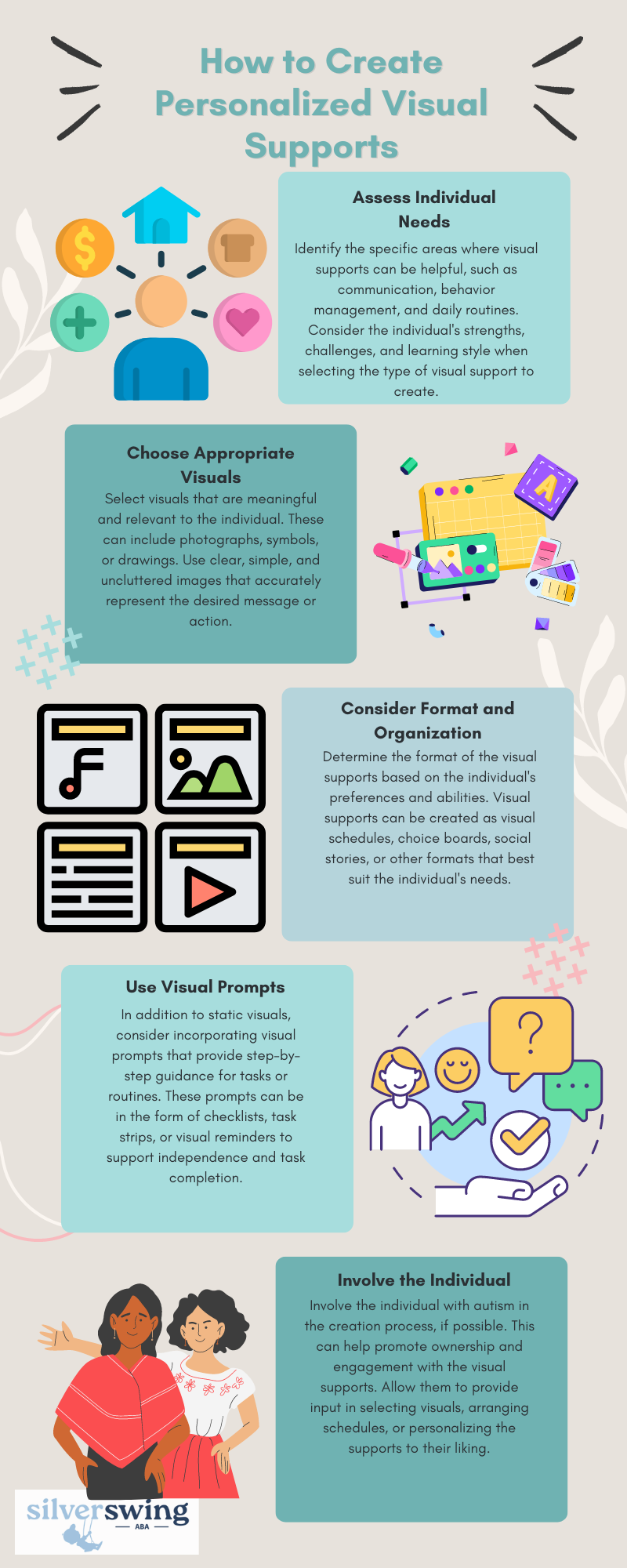Research has shown that visual supports can be particularly helpful for individuals with autism due to their visual processing strengths.
According to studies, visual supports have been found to improve communication, reduce anxiety, enhance understanding, and promote independence in individuals with autism.
By incorporating visual supports, individuals with autism can better navigate their environment, understand expectations, and communicate their thoughts and feelings. Visual supports can be customized to meet the unique needs of each individual, making them an invaluable tool for promoting inclusion, learning, and independence for individuals on the autism spectrum.

Benefits of Visual Supports
Visual supports offer numerous benefits to individuals with autism, their parents, and caregivers. Here are some of their key advantages:
- Enhanced Communication – Visual supports provide a visual representation of language, making it easier for individuals with autism to communicate their needs, wants, and thoughts. They can use picture exchange communication systems (PECS), where they exchange pictures or symbols to express their desires or refer to visual schedules to understand and follow daily routines.
- Improved Comprehension – Visual supports help individuals with autism comprehend and understand various concepts, instructions, and expectations. By presenting information visually, it enhances their understanding of tasks, social situations, and behavioral expectations. Visual supports such as social stories can be particularly helpful in teaching appropriate social skills and behaviors.
- Reduced Anxiety – Individuals with autism often experience anxiety due to uncertainty and difficulty understanding their environment. Visual supports provide a sense of predictability and structure, reducing anxiety and promoting a sense of security. Visual schedules, for example, help individuals anticipate and prepare for upcoming activities or transitions, reducing stress and promoting a smoother transition.
- Promotion of Independence – Visual supports empower individuals with autism to become more independent in their daily lives. By providing visual cues and reminders, individuals can navigate tasks, routines, and social interactions with greater confidence and autonomy. Visual supports enable them to take ownership of their actions and make choices, fostering independence and self-determination.
- Facilitation of Learning – Visual supports enhance learning opportunities by breaking down complex information into manageable visual representations. Visual aids can be used to support academic learning, memory recall, and understanding of abstract concepts. For instance, visual supports can be employed to present mathematical or scientific concepts in a more concrete and accessible manner.
- Improved Social Interaction – Visual supports help individuals with autism navigate social interactions more effectively. Social stories, for example, provide visual narratives that depict social situations, appropriate behavior, and expected social cues. By using social stories, individuals can better understand social expectations and engage in more successful social interactions.
By harnessing the power of visual supports, individuals with autism can better navigate their environment, communicate their needs, and enhance their overall quality of life. These supports offer a wide range of benefits, empowering individuals with autism to thrive and reach their full potential.

Types of Visual Supports
Visual supports play a crucial role in enhancing communication, understanding, and independence among autistic individuals. That said, there are various types of visual supports that can be implemented to cater to the unique needs of individuals on the autism spectrum.
Let’s look at each of them.
Picture Exchange Communication System (PECS)
The Picture Exchange Communication System (PECS) is a widely recognized method used to enhance communication skills in individuals with autism. PECS utilizes a system of exchanging pictures to initiate and maintain communication.
This allows individuals to express their needs, desires, and thoughts by selecting and handing over a picture card to a communication partner.
The benefits of PECS include promoting functional communication, reducing frustration, and increasing social interaction. Research suggests that PECS can lead to improvements in speech, social-communicative behavior, and problem behavior.
PECS is often introduced through structured training, gradually building the individual’s ability to initiate and construct more complex messages.
Visual Schedules
Visual schedules are a valuable tool for individuals with autism as they provide a visual representation of a series of activities or tasks. These schedules use pictures, symbols, or words to help individuals understand the sequence of events and transitions throughout their day.
Visual schedules offer predictability, reduce anxiety, and enhance independence by providing a clear and structured framework.
By breaking down activities into manageable steps, visual schedules promote task completion and aid in transitioning between activities, among other benefits. They can be customized to suit the individual’s needs and can be displayed using various formats such as visual boards, calendars, or portable cards.
Visual schedules are particularly beneficial for individuals who thrive on routine and benefit from visual cues to navigate their day.
Social Stories
Social stories are narrative-based interventions that aim to teach individuals with autism about social situations, expectations, and appropriate behaviors. They use descriptive and directive sentences accompanied by relevant visuals to provide individuals with a clear understanding of what to expect in social settings.
Social stories can be created to address a wide range of social situations, including greetings, turn-taking, and problem-solving. They help individuals with autism develop social skills, reduce anxiety, and enhance social understanding.
Social stories are most effective when personalized to the individual’s specific needs and interests, ensuring relevance and engagement.
Implementing visual supports such as the Picture Exchange Communication System (PECS), visual schedules, and social stories can have a positive impact on individuals with autism. These visual supports promote communication, independence, and social understanding, allowing individuals to navigate their daily lives more effectively.
By understanding the unique needs of each individual and tailoring visual supports accordingly, caregivers and educators can provide valuable tools for enhancing communication and overall well-being.
Visual Timers
Visual timers provide a visual representation of time passing, which helps individuals understand the concept of time and manage it better. These timers are particularly useful for tasks that have a set duration or for managing transitions between activities.
Traditional visual timers use numbers and countdowns to show the passage of time. These timers can be effective for individuals who understand numerical concepts.
For instance, setting a timer for 10 minutes to complete a task helps the individual pace themselves and understand how much time they have left.
Color-coded timers, on the other hand, use colors to represent time segments. For example, a timer might start with a green section that gradually turns yellow and then red as time runs out.
This type of visual representation can be more intuitive for some individuals, providing a clear and immediate understanding of how much time is left without needing to interpret numbers.
The primary benefit of visual timers is improved time management. For individuals with autism, understanding and managing time can be challenging. Visual timers make the abstract concept of time more concrete, helping them grasp the passage of time and manage their activities accordingly.
This can lead to better task performance, reduced anxiety related to time constraints, and smoother transitions between activities.

How to Implement Visual Supports
Visual supports play a crucial role in enhancing communication and reducing anxiety for individuals with autism. Implementing these supports in daily routines can greatly benefit individuals on the autism spectrum.
Here’s how to properly implement them.
Creating Personalized Visual Supports
Creating personalized visual supports involves tailoring the visuals to meet the specific needs and preferences of the individual with autism.
Here are some steps to follow when creating personalized visual supports:

Incorporating Visual Supports in Daily Routine
To maximize the effectiveness of visual supports, it is important to incorporate them into daily routines consistently. Here are some strategies for integrating visual supports into daily routines:
- Establish a Visual Routine – Create a visual schedule or timetable that outlines the daily activities and routines in a clear and sequential manner. Display the schedule in a prominent location, such as on a wall or using a portable visual schedule. Refer to the schedule regularly to provide predictability and structure.
- Provide Visual Cues – Use visual supports to provide cues and reminders for specific tasks or transitions. For example, visual timers or countdowns can help signal when a task is about to end or when it is time to transition to the next activity. Visual cues can help reduce anxiety and facilitate smoother transitions.
- Reinforce Communication – Incorporate visual supports that support communication, such as the Picture Exchange Communication System (PECS). PECS uses visual symbols to facilitate communication and can be implemented during daily routines to encourage the individual to make choices, request items, or express their needs.
- Create Visual Supports for Social Skills – Develop social stories or visual scripts that provide guidance on appropriate social behavior and interactions. These visual supports can help individuals with autism understand social expectations, navigate social situations, and reinforce positive social skills.
By creating personalized visual supports and integrating them into daily routines, individuals with autism can benefit from increased understanding, reduced anxiety, improved communication, and enhanced independence.
Consistency and individualization are key when implementing these visual supports to maximize their effectiveness and support the unique needs of individuals with autism.




